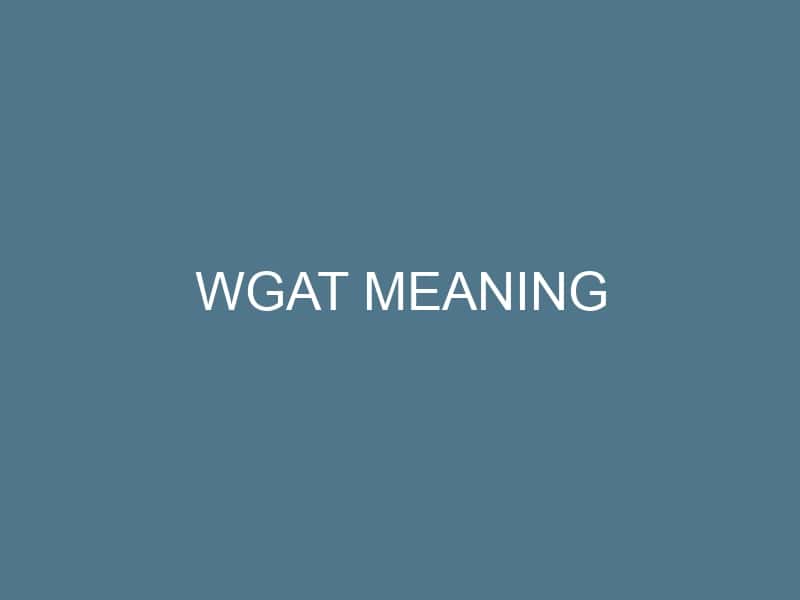In today’s fast-paced digital world, internet acronyms are a ubiquitous part of online and text communication. These abbreviated forms of expressions are designed for speed and efficiency, and they are used widely across various platforms such as social media, instant messaging, and emails. However, not every acronym is well-known or easy to understand, and “WGAT” is one such term that has left many users scratching their heads. What does it stand for, and how is it used in digital dialogue?
| Understanding “WGAT” and the World of Internet Acronyms |
|---|
| 1. Prevalence of Internet Acronyms: Internet acronyms are part of everyday online communication, designed for quick and efficient dialogue. |
| 2. The Mystery of “WGAT”: “WGAT” is not widely recognized and might be a niche acronym or a misspelling, with potential meanings like “Who Gives A Toss?” or “Where’s The Good At?”. |
| 3. Advantages of Acronyms: They facilitate speed, brevity, and connection in online interactions, creating a shared understanding among communicators. |
| 4. Common Acronyms: Examples include “BTC” for “Better than Coffee”, “TYT” for “Take Your Time”, and “FR” for “For Real”, each with a clear and specific meaning. |
| 5. Emotional and Expressive Acronyms: Acronyms like “LMS” (Like My Status), “IMU” (I Miss You), and “SMDH” (Shaking My Damn Head) convey actions and feelings. |
| 6. Acronyms for Conversations: Acronyms can express sentiments or act as conversational shortcuts, like “WTD” (What’s The Deal?) or “OFC” (Of Course). |
| 7. Importance of Acronym Knowledge: Keeping up with internet acronyms is vital for effective digital communication and helps integrate into online communities. |
Unpacking the Acronym “WGAT”
The term “WGAT” is not one of the most common acronyms you’ll encounter online, and as a result, there’s some confusion regarding its meaning. Generally, “WGAT” isn’t a standard acronym with a widely accepted meaning like “LOL” (Laugh Out Loud) or “BRB” (Be Right Back). It could be a misspelling or a niche term used in specific online circles. When acronyms are not standardized, their meanings can vary widely based on context and community.
- Possible interpretations of “WGAT”:
- “Who Gives A Toss?” – a dismissive response.
- “Where’s The Good At?” – a question about quality or excitement.
- Other variations depending on community and context.
Role of Acronyms in Online Communication
Despite the ambiguity of “WGAT,” acronyms as a whole play a critical role in online communication. They are integral in conveying messages quickly and often embody a sense of informality and camaraderie among users.
- Advantages of using acronyms:
- Speed: Allows for quick typing and reading.
- Brevity: Keeps messages short and to the point.
- Connection: Creates a shared understanding among users.
Similar Commonly Used Acronyms and Their Meanings
While “WGAT” might be less familiar, there are many acronyms with clear, defined meanings that are widely recognized in the online community. These acronyms are valuable linguistic shortcuts that people use every day.
- “BTC” as in “Better than Coffee” – BTC Meaning
- “TYT”, meaning “Take Your Time” – TYT Meaning
- “FR”, representing “For Real” – FR Meaning
These acronyms help carry the conversation with ease, providing quick and commonly understood responses.
More Internet Acronyms Explained
Continuing with our exploration of internet acronyms, here are additional expressions that are often used in online communications:
- “TTM”, which stands for “Talk To Me” – TTM Meaning
- “ISTG”, often used to express “I Swear To God” – ISTG Meaning
- “IHHT”, meaning “I Hate Having To” – IHHT Meaning
Using these acronyms not only speeds up typing but also adds a layer of emotion or emphasis to a message.
Acronyms Reflecting Actions and Emotions
Acronyms also serve to convey actions and emotions, which can be especially important in an environment where verbal cues and body language are absent. Consider these popular expressive shortcuts:
- “LMS”, standing for “Like My Status” – LMS Meaning
- “IMU”, meaning “I Miss You” – IMU Meaning
- “HYB”, representing “How You Been?” – HYB Meaning
- “FYP”, typically used in the context of “For You Page” on TikTok – FYP Meaning
These acronyms may reflect a request, sentiment, or question that enhances online interaction.
Expressive Acronyms and What They Convey
Acronyms can also serve as powerful expressions of feelings or attitudes that may be cumbersome to spell out fully:
- “SMDH”, an expression of disappointment or disbelief, meaning “Shaking My Damn Head” – SMDH Meaning
- “BFFR”, denoting “Best Friends For Real” – BFFR Meaning
- “IKYFL”, or “I Know You’re Feeling Lazy” – IKYFL Meaning
- “GRWM”, used as “Get Ready With Me”, often in the context of videos or tutorials – GRWM Meaning
These acronyms often add a layer of personal touch or emotional context to a conversation.
Acronyms Used for Questions and Decisions
In addition to expressing emotions, acronyms can pose questions or facilitate decision-making processes. Here are a few examples:
- “WTD”, asking “What’s The Deal?” – WTD Meaning
- “OMM”, questioning “On My Mind” – OMM Meaning
- “OFC”, simply meaning “Of Course” – OFC Meaning
Such acronyms make it crisp and clear when seeking answers or confirming decisions within the flow of an online conversation.
Conclusion
Understanding and using internet acronyms like “WGAT,” whether well-known or less common, is essential in today’s digital age of communication. They not only make our online interactions quicker but can also foster a sense of community and shared knowledge. To keep up with the evolving landscape of internet language, it’s important to stay curious and learn more about how acronyms are shaping the way we connect with each other online.







